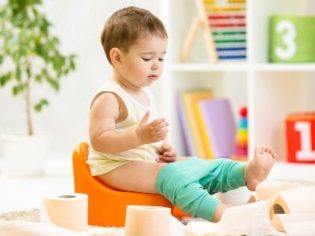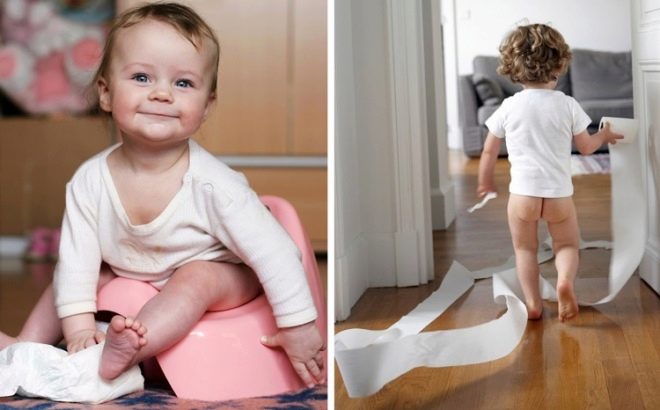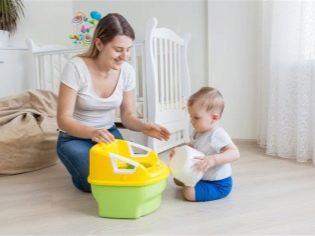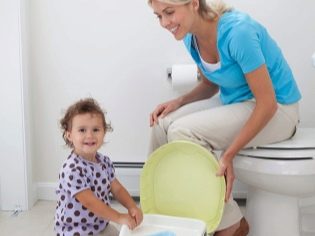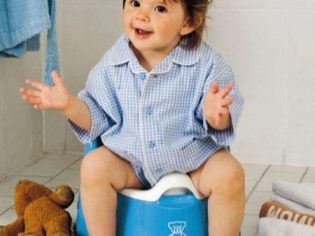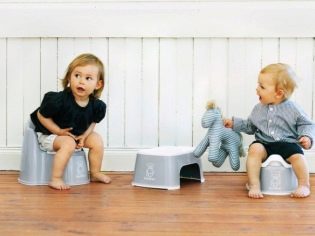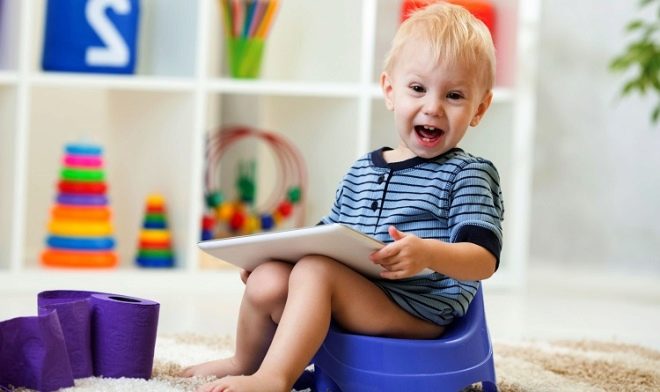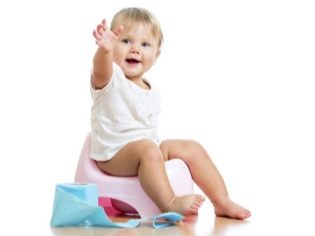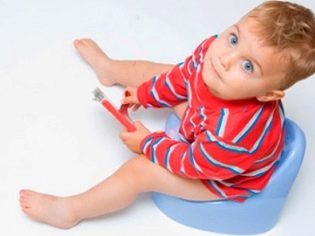How in 2 years to accustom the child to the pot?
When mothers did not have disposable diapers, the issue of potty training was not so acute. To save herself from unnecessary washes, the mother began to teach her baby to the pot from an early age. In the year, most of the babies knew perfectly well what it was and why they needed the pot, especially since it was uncomfortable in wet cloth diapers and pantyhose and the children themselves. As soon as disposable diapers appeared, the mothers had less trouble and worries, as did the laundry. Yes, and children have become much more comfortable and more pleasant, because the diaper can be wet for several hours without delivering any discomfort to the child.
As a result, the age of potty schooling has systematically shifted - modern children much later become familiar with the pot than their parents in their childhood. And because the question of how to teach a child to go to the pot in 2 years and after two years, no one is shocked. In this article we will tell you how to teach your baby to handle the pot on their own and open some secrets that will help mothers in such a difficult task.
Baby's readiness
A clear sign of “adulthood” of a child is the ability to independently use a pot or toilet for great and small need. All moms certainly want to see the baby big and independent. But until a certain age, especially if there is no need to give the child to the nursery, it is more convenient for him and his mother to use disposable diapers. According to the established practice, this age is considered 2 years.
When a child reaches two years of age, parents have a reasonable desire to stop spending the family budget on expensive diapers and inculcate health skills in the child, without which it will be difficult to get a kindergarten or go on an exciting trip. At 2 years and later of this significant date, as a rule, a large-scale struggle with diapers takes place, which pretty much exhausts both adults and a distracted toddler.
Before you get down to business, experts recommend assessing the readiness of the toddler for the coming changes. Grafting a new skill in any case will be stressful for all participants in this process.
Child's readiness is evaluated by several parameters. When a person is born, urination and defecation are unconditioned reflexes that the child can not take control of, and it is not required for some time. At a certain stage of development, the unconditioned reflex becomes conditional, that is, the child associates a desire to pee or empty the intestines with the action itself.
It is after the reflex becomes conditional, you can try to start training the child. At an earlier age from the baby, associative urination into the pot can be achieved by the command “pi-pi”, but when the reflex becomes conditional, the baby may refuse to execute commands and will again begin to do its “work” in the pants.
The reflex becomes conditional as the child grows, as the functions of the cortex of the brain and nervous system improve. The age at which the processes of the formation of the reflex can be considered completed or almost completed, it is considered exactly two years of age. Thus, you can start preparing for the development of "toilet science" after the baby celebrates the second birthday.
Readiness for planting on the pot is easy to evaluate. According to the world famous pediatrician Yevgeny Komarovsky, it is enough to observe the child carefully for several days and honestly answer a few questions (if there are a majority of positive answers, you can try to inculcate new sanitary skills to the toddler).
- Does the child have a bowel movement regimen? Does he go around at about the same time every day?
- Can a toddler at least an hour and a half pass in a clean and dry diaper after a change? Does he manage to restrain urination, even during this time?
- Does the baby know the names of parts of his body, does he know him, can he understand the names of the items of his wardrobe (panties, pants, skirt, etc.)?
- Does he understand the meaning of the verbs "to urinate" and "poop"? Does this process associate with these words?
- Does the baby irritate a wet or dirty diaper, is it trying to remove the diaper after a certain action?
- Can a child take off his pants, underwear?
- Does the child have access to the toilet room? Does he enter it without fear or fear?
Children after 2 years, as a rule, perfectly understand the speech of parents. Even if they still do not speak well, their passive speech is sufficiently developed to understand exactly what adults say. Therefore, it will be much easier for the child to explain why a new item called the “pot” is needed and what to do with it. If in the process of learning a child resists, cries, protest, it will be better to postpone training for a later time. Perhaps in a few days or weeks, the baby will begin to perceive the pot and everything connected with it in a new way.
Preparing parents is to find a week or two of free time, if they work, and spend it with the baby. You will also need a reserve of patience and strength, because not everything will be obtained from the first and even from the second time.
At the time of the start of training, the child must be healthy, he should not be under the influence of certain stress factors, for example, moving, starting a kindergarten, parting with one of the parents or their divorce.
The better and more psychologically comfortable the child feels at the very beginning of learning, the more likely the event will be quick success.
Why do children refuse?
Often parents are faced with a situation where a two-year-old son categorically refuses a pot - does not want to sit on it, does not approach him, and in every way tries to avoid his mother’s attempts to acquaint him with the pot closer. What could be the reason for this two-year-old behavior? Let's look at things through the eyes of the kid himself.
- The pot is uncomfortable. If the parents did not take into account the requirements for choosing the first pot, which we describe below, it may turn out that the first experience of “communicating” the child with the pot turned out to be negative - the pot was cold, hard, too small or too big. In the end, the pot can be unattractive in appearance and frighten the child.
- Fear. A child who has already been tried to force him to sit on the pot, and with force and shouts, is afraid of the pot, since this accessory is not associated with safety and pleasure. Fear can manifest itself not only in the refusal to sit on the pot. Often the child who has already been taught to sit on it, just sits on it, does not poop and does not pee, but as soon as the parents lift him from the pot, he immediately fulfills both needs in his pants.
- The child is not ready. This also applies to physical and psychological readiness. He simply does not associate the pot with toilet needs, and therefore does not ask for it. Readiness is a relative concept. A child may be ready at the age of 2 years evenly, or maybe at 2.6 or 2.8 years old he will not show signs of readiness.
- Stress. The kid can painfully perceive the beginning of learning.Parents refuse to use the usual for the baby diapers, resulting in a way out of the so-called zone of psychological comfort.
Children 2 years and older seek independence, they already know how to defend their interests and their desires, so a protest against a pot can be strong, pronounced and long lasting. The main thing here is not to lose patience, not to retreat, not to be derailed by adults. As a child once got used to a disposable diaper, so he gradually gets used and adapts to the pot. And it needs to be understood.
Not a single child has ever been sent to the first grade, not knowing how to write and crumble where the sanitary and social norms of behavior adopted in our society require.
The more parents show disappointment and anxiety over the child's rejection of such a thing as a pot, the stronger the baby will block out from him, because in his little head the relationship between this object and the frustrated kind of mother quickly develops, which he does not want upset.
How to teach?
There are several ways to potty training in 2 years. There are ways fast, slow and gentle, universal. For starters, parents should know exactly how much time they have. If it is time to take the child to the kindergarten, a place has appeared that can be taken by others if delayed.
Or maybe the family decided to go on a trip and already bought tickets, then you can use the quick way. If there is time, it tolerates, then it is better to go on a slower, but less psychologically traumatic way or use the universal method.
Express method
A quick method came up with a kid's doctor, Gina Ford. Her method is designed for two-year-olds, as well as children from 1.5 to 2.5 years. The doctor suggested that toilet training "science" can "fit" in just 7 days; a child who is ready to learn can write and walk large in a potty, which can be learned in just a week. On the first day, Dr. Ford advises starting training in the morning. After removing the diaper, which was filled at night, the child is immediately "presented" with a new "friend" - a beautiful pot and always pre-heated in warm water. The baby should be seated on the pot and kept on it for about 10 minutes. Of course, the mother will have to think out in advance what they and the child will do in these 10 minutes.
It is necessary to prepare for the fact that the child refuses to sit on the pot, and there is nothing unexpected or strange in this. In advance, take with you a toy that the baby loves. This may be his nightly toy, with which he sleeps. The right of the first landing on the pot can be given exactly to a teddy hare or bear.
Unnoticeably for the baby, pour some water into the pot with the sitting hare, then show the result of the hare's “efforts” to the toddler, praise the hare from the heart and have the child repeat his deed.
Of course, the game will interest the baby, but the baby can refuse to sit down and repeat the “feat”. And this, too, is nothing strange. Do not insist. Do not wear a baby diaper. Throughout the first day, the baby, and if necessary his bunny, should be offered a pot every 15-20 minutes. Believe me, at the end of the day, the baby will do what follows. At this moment, do not forget to arrange a small "celebration" - praise the child, treat him with something tasty, tell all the family members with the child what a fine fellow he is. The child will quickly understand that such actions are good and constructive.
Of course, there will be several “misses” during the day. The kid will wet his pants, he himself is experiencing a lot of inconvenience because of this. Try to be calm. Gina Ford recommends restraining emotions, not scolding a child, but in a firm and even voice, changing his pants, to express her displeasure with the kid's act. The main thing is to do it kindly, without the slightest note of irritation and anger. For the night after the first day they wear a disposable diaper to the child.
On the second day, you should consolidate your skills. The pot is still offered every 15-20 minutes. Diversify the action can be a joint removal of the pot in the toilet, pouring it.
Allow the child to flush the water, without exception, all the kids just love to press the toilet button. If the child has already learned what to do with the pot, try to do without a plush helper.
On the third day, the mother and the child go for a walk, but not on their own, but with the pot. Pediatricians warn parents against a common mistake - wear a diaper for a walk. The baby will quickly return "to the roots." During the walk you need to ask if the child wants to go to the toilet every 20 minutes. Well, if it is summer outside, a walk with a pot in your hands will not be a serious hassle. If it is winter in the yard, it is better to refrain from walking. According to Ford, at this stage it is more important to master the toilet skill and only then go outside with the child.
The fourth, fifth and sixth day are approximately as the first three. The child walks at home without a diaper; you can only wear it during daytime sleep and at night. They take the pot with them for a walk, and at home, with the help of mother, the baby “remembers” about its existence not every 15, but every 30-40 minutes. On the seventh day, you can sum up the first results and draw conclusions. The boy or girl is no longer offered a pot, although he still stands in the most visible place, he is also taken outside.
Mom needs to be very vigilant to monitor how the baby behaves. If the quick course is successful, the child will show by behavior what he wants on the pot. Kids start to worry, the most savvy can bring mom a pot, sit on it, show it.
Fast training does not apply at night. If the baby sleeps well and fast, he quickly falls asleep after an accidental awakening, pediatrician Ford is recommended to try to wake him up and offer the pot at night, but not earlier than on the fifth or sixth day after the start of schooling. If the child is distinguished by increased excitability, it is difficult for him to fall asleep, it is not necessary to do this yet - everyone will be much calmer if the child spends the night in a disposable diaper.
Universal method
This method implies more time-consuming than a quick, but parents' feedback suggests that the result will be more stable. A big “fan” of the universal method of schooling is the famous pediatrician Yevgeny Komarovsky. At the initial stage, a two-year acquaintance with a pot. They show how to open and close it, how to sit on it and how to get up from it. Next, remove the diaper from the baby and monitor the behavior of the crumbs. The first time the pot is “served” in the morning after waking up, and then after each meal or drink, and also when the child shows signs of anxiety.
Successful attempts should be generously encouraged, unsuccessful - not to condemn, not to scold the baby. The universal method involves turning toilet exercise into an interesting activity, in which everything is consistent - the child is taught to take off his pants, to put them on, to take the pot behind him and to flush his contents down the toilet.
The universal method does not imply the complete abandonment of diapers. They can continue to wear for a walk, for a comfortable lunch or night sleep. The process of habituation, therefore, will be gradual and unhurried.
Slow method
It differs from the universal only in that the child is left without the usual diaper only in the first half of the day, before lunchtime. The rest of the time the baby can lead a familiar life. This method has its advantages - the stress associated with the transition to new living conditions will be minimal for both the baby and his parents. At any time, parents can refuse to study, postpone it "for later" if the baby is sick or naughty.
However, it is not worth waiting for the result quickly - even having learned what the toilet construction is for, the baby can sometimes urinate into his pants.
Tips
There are other methods that parents can combine, use one at a time or in combination with each other at their discretion, depending on the characteristics of the child’s character, development and readiness to grasp a new skill. In 2 years, kids are very quick-witted, and if not one method, then the other will necessarily be effective.
- You can place the pot in the toilet room and go to the toilet with the child. At the same time you can open the tap, because the sound of water in any person causes the desire to quickly pee. This is where the idle pot will come in handy.
- If the child is afraid of planting on the pot, put him on the subject right in the clothes, without removing his pants. When the crumb learns to sit down without fear, gradually begin to take off his pants and panties. And only after that go to the main part of the training.
- Do not leave the child alone during his "meeting". The presence of adults is necessary so that the baby does not fall from the pot, not be injured, not frightened. In addition, learning is much faster if the child is interested and motivated for the result. In the process, tell him tales, sing songs, read his favorite poems.
- Adult men in the family can take the boys to the toilet, and women - girls. Seeing how adults fulfill their needs, the child will be more sympathetic to the pot, he will understand that this is completely natural. In addition, children love to imitate adults - they need to skillfully use.
- With the same success, younger children copy the behavior of their elders. If a child has a brother or sister who go to the pot on their own, we can assume that the parents are very lucky.
A child who, in 2-2.5 years, refuses to go to the pot, does not need medical assistance, as some people think. He needs the participation and understanding of his childish attitude. A pediatrician and a psychologist should be approached only if the baby does not recognize the pot after he turns 3 years old.
Training in toilet and sanitary skills will be easier and easier if parents think through some important details.
- Pot. It should be comfortable, bright. For boys - with an oval hole, and for girls - with a round. The best material is environmentally friendly plastic, since enameled pots, which have grown into half of today's adults, are very cold and unpleasant, besides requiring more thorough washing and care. The pot should have a small back, a stable base.
It is better to refuse pots with music and a built-in video player - the kid should not perceive the toilet item as entertainment, otherwise the learning process may take a long time. Little what a kid wants to defend the need for an interesting and exciting toy.
- Cleanliness. The child must understand that walking dirty and wet is bad, unpleasant and not accepted. Therefore, teaching him to the pot should begin with the schooling of purity. A child who has been accustomed to be in a dirty diaper for hours will be difficult to learn to cope with a need in a certain place.
- The reaction of the parents. When a baby starts walking without a diaper, some parents instinctively strive to “catch” it just when the process of bowel or bladder emptying is just beginning. Frightened toddler dragged to the pot. This is a big mistake. The baby will not be able to stop urinating anyway, but the fear of physiological natural actions may creep deep into his soul and subconsciousness. It is much simpler and more correct to remove the expensive bright carpet from the room when teaching the child toilet skills, always to keep a bucket of water and a rag ready to eliminate the consequences of child blunders.
- Timing. Try to combine training with the onset of summer, the end of spring, or the beginning of autumn.When it is warm outside, it is much easier to take a child without a diaper for a walk, to walk in minimal clothes, which, moreover, will dry much faster after washing.
And finally, I want to note that you can not compare your child with other children. If the neighbor boy has been going to the pot perfectly since the age of one and a half years, and your scion of 2.5 years does not even want to come close to this device - this is not a reason to worry. Mom can not be accused of pedagogical neglect of the baby.
To learn how to teach a child to the pot, see the following video from Dr. Komarovsky.


